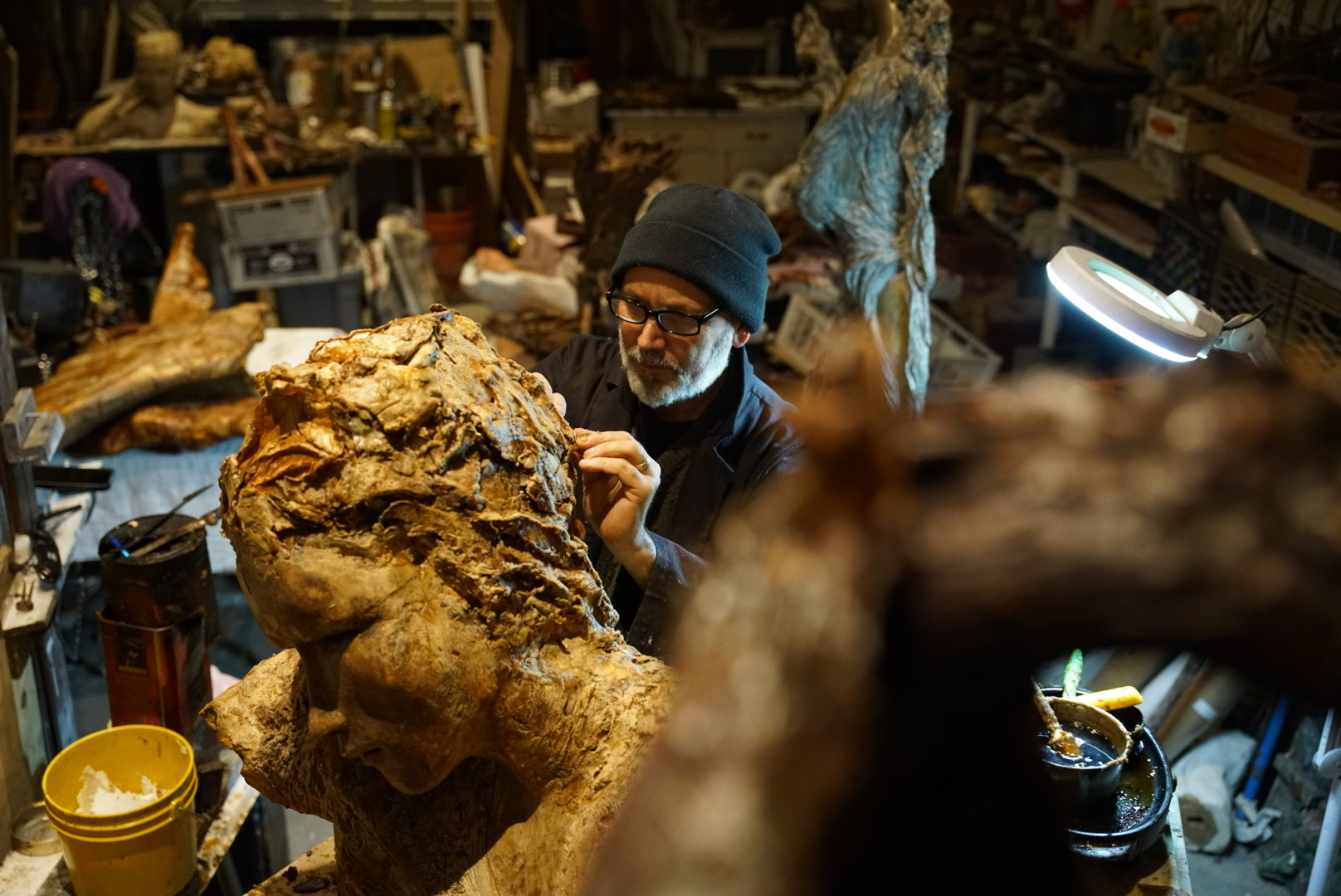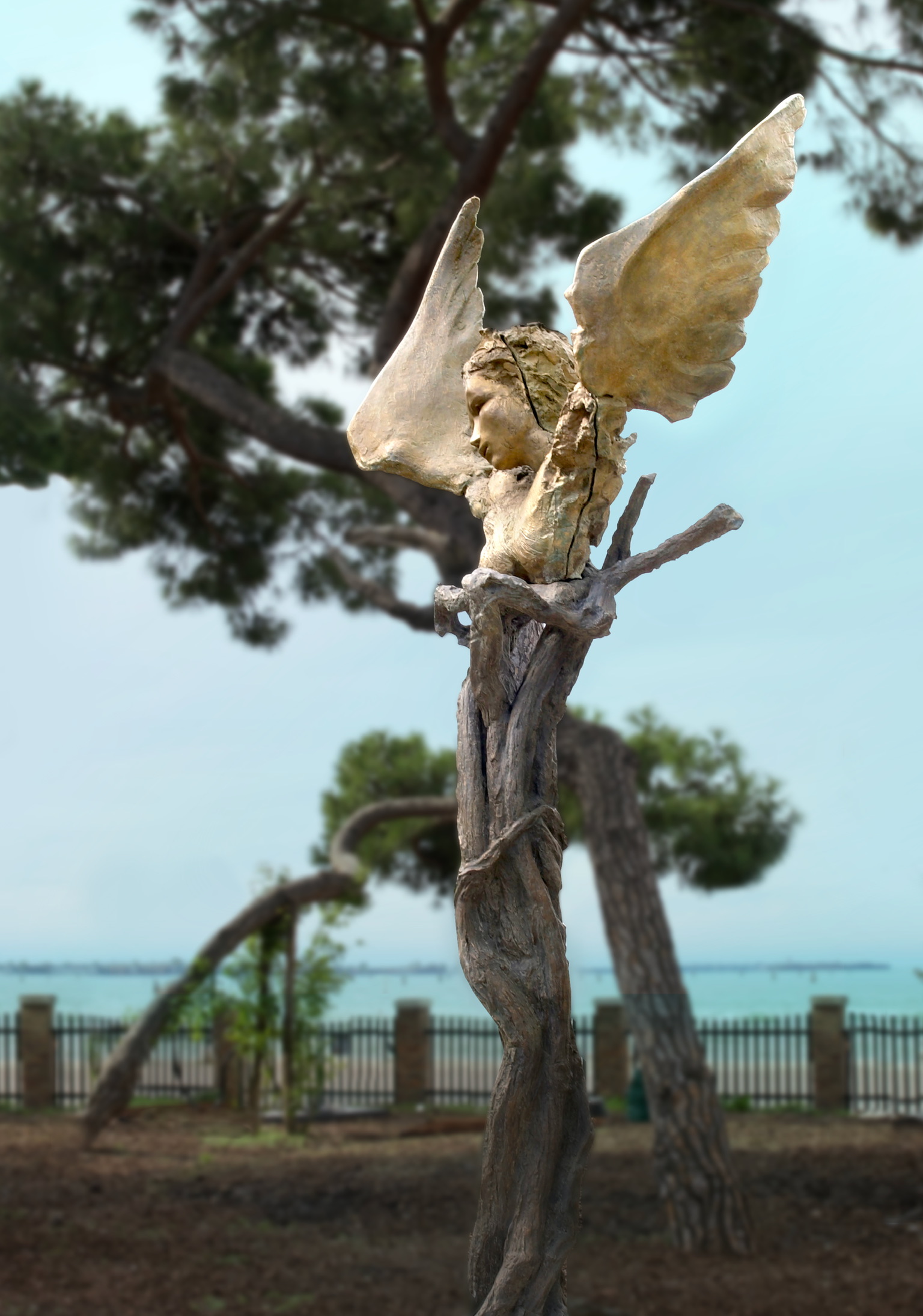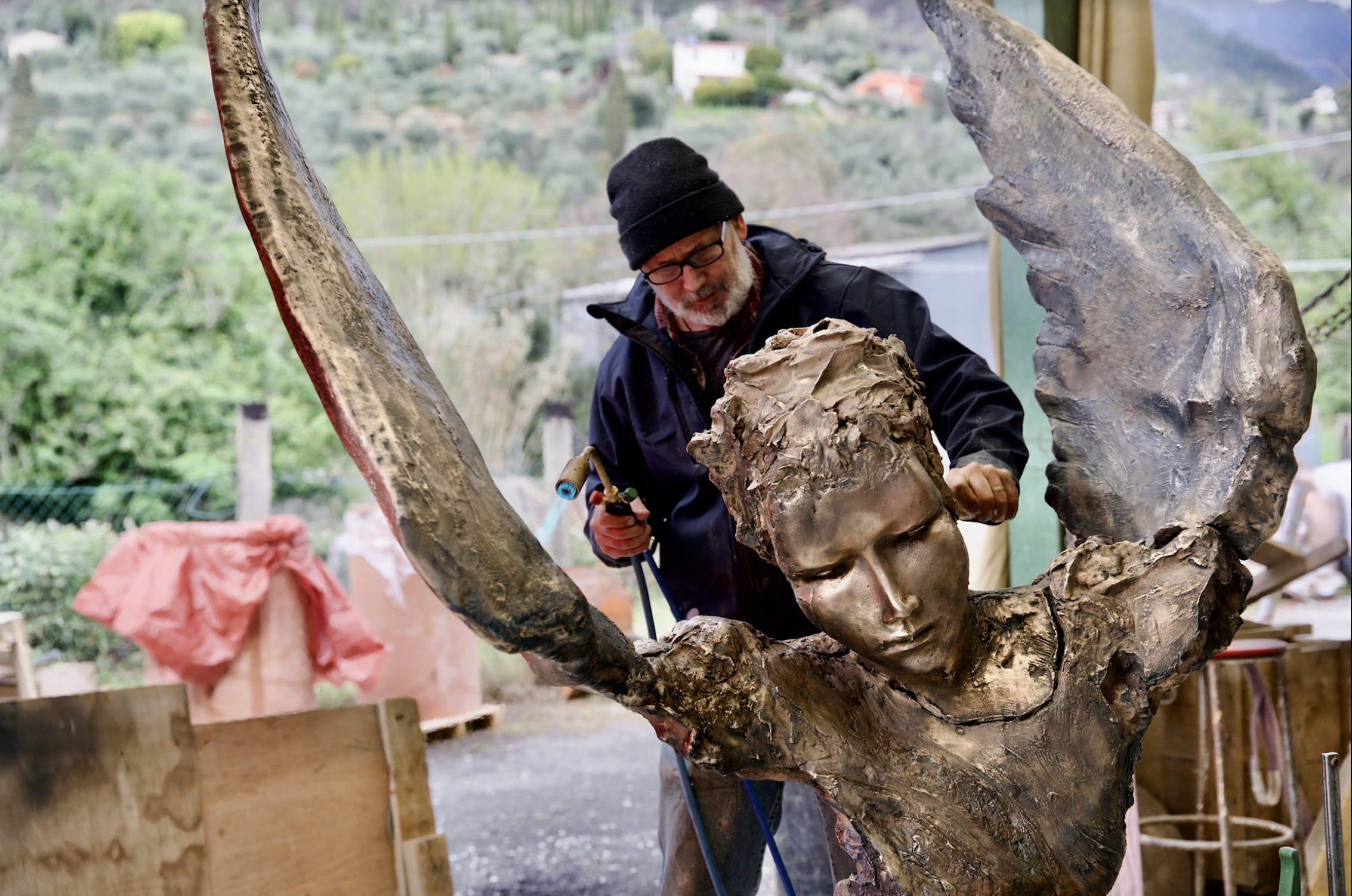American sculptor Romolo del Deo created a 14-foot-high monumental bronze sculpture for the European Cultural Center as part of the Venice Art Biennial. The piece, “The Tree Of Life Which Is Ours,” addresses the rise of sea level, which threatens Venice’s cultural heritage.
In our interview, the artist shares his approach to sustainable art and how science has influenced his artistic practice. He also introduces the concept of “Long Art,” a more environmentally conscious approach to creating.
What inspired your monumental bronze sculpture, The Tree of Life, Which Is Ours, created for the European Cultural Center at the 2022 Venice Biennale?
Romolo del Deo: The Tree Of Life Which Is Ours owes its title to the concept that we are bound in fate with trees. The park on the Venice waterfront, where the sculpture is installed, is full of trees that bear vivid signs of their struggle to deal with the rising waters of Venice. In a way, the park is itself a slow motion drama about sea level rise recorded in its trees. I wanted to connect my work to this story.
There is a global phenomenon known as ghost forests. These are spectral desiccated forests composed of trees, usually hardwoods, that have had rising salt water get into their tap roots, killing them. The significance of this is that climate change deniers will often point to periodicity of climate cycles over decades to minimize or seek to debunk the concerns of global warming. However, ghost forests are usually composed of trees that have survived over decades, even centuries, but are now subjected to the effects of rising sea levels not previously recorded in modern times. Their deaths cannot be explained away by decadal cyclical weather patterns. They are a message, as imperative to survival as a dead canary in a coal mine. I used fallen wood collected from ghost forests to create the trunk of my sculpture.
In pondering the connection between the imperiled lives of trees and the entwining of our fates with theirs, I thought of figures in myth and lore who became or lived in trees. This led me to sculpt Daphne as part of this piece. She was a goddess of free-flowing waters who became a tree to escape the pursuit of Apollo, the sun, and in so doing she bound her existence to a tree. We have, in essence, all bound our existence to trees. If they are in danger, we are in danger. We are all Daphne.
You have explained that your inspiration for this project was both climate science and myth. How did these two inspirations converge?
Romolo del Deo: Myths are powerful tools for telling stories because they tend to have been embedded in us on both a conscious level as learned knowledge and a subconscious level as the underpinnings of so much of culture. Climate science is a hard story to tell and many well-intentioned advocates for climate science fail to understand that many are inured to the deluge of pressing facts and data. They can’t grasp it and so it fails to impress them. They need stories, and myths are there to tell stories we can learn from. Freud used mythology this way to explain psychiatry. It can also explain climate science. For me the convergence was natural. The site in Venice already looked like the trees were frozen in writhing attempts to escape the rising seawater. It was not hard to imagine them taking possession of spirits trapped in them like mythological beings. From there, the evolution of the piece was natural and all I had to do was let it guide me to tell its story and share with me the insights it taught me about climate science and its manifestation in sea level rise.
Is this typically how you draw inspiration for your projects, especially when incorporating the natural world?
Romolo del Deo: Yes, this is how I work, incorporating objects from the natural world with studio pieces, studies, fragments of studies, or simply following the forms the natural objects suggest until the original object is no longer defined by its old identity and has found a new one.
You often cast and recast your sculptures. How does time affect your work?
Romolo del Deo: Time improves everything. I learn by letting work settle in my mind, accompanying me in the studio until it is ready to grow, transform or fracture into something new. I often cast and then break my castings, then live with the remains until something grows from them. Much like a farmer plowing under a crop to enrich the soil so new growth will come in a new season. Without time this is not possible. It cannot be rushed and it does not honor my deadlines or schedules. The trick is to work on enough different threads of ideas so that you can allow each its own time to become. When one idea needs to be put aside to find its time, I plant the seed for another.

By repurposing not only your sculpture casting but also artistic methods from antiquity, what do you hope to communicate to contemporary audiences?
Romolo del Deo: I am a great lover of art, all art. Not just the kind I do. I love the heterogeneity of artistic endeavor, but I am concerned about the tendency of the art world to leave heirloom methods and materials behind. I think this knowledge and art made this way is not unlike those rare creatures that fauna and flora scientists uncover in remote places, whose genes hold miraculous secrets to help us find cures for illnesses. I think that ancient methods also may hold cures. Just as biodiversity makes us all stronger by preserving the gene pool, creative diversity also protects us from driving all art making into a cul-de-sac, irreparably dependent on industrial production, technology and synthetic materials. Think of it like “crea-diversity.” We are stronger when all methods and all ways of creating art are kept as part of our living culture, not just the stuff of history.
What is your personal history with art?
Romolo del Deo: I grew up in a household of art; my father and grandfather were artists. My mother was, among many things, a poet, fiber artist and art historian. Art making was a normal thing to do. It was a constant center of conversation. Artworks and art books were everywhere in my home, and many of my family’s friends were artists and creatives. My childhood playmates were all artists’ children. Making art was always such a wonderful thing to do, so the question was never why make art but why would anyone ever want to do anything else?
Was there a pivotal moment in your career that propelled your work?
Romolo del Deo: I think we are often propelled forward by facing failure or defeat. It doesn’t necessarily need to come from without, it can also come from within. I started art making very early in life, and I experienced an accelerated and precocious rise, winning awards, scholarships and grants, always looking to the next accolade. I realized in my mid-twenties that I had lost track of the reason I made art and what I wished to say with it, focused as I was on the response of others to my work. I realized that if I followed this path I would extinguish my art. I would become the purveyor of a corpse, created for others and defined by their goals for it. So I stepped off the merry-go-round of approval. I unplugged from the world of art academia and isolated myself on a mountain top in Tuscany until I rediscovered my original impetus for making art for myself. Making the art I desired, not what galleries or curators wanted. That was my pivotal moment.

How do your studios in Provincetown, MA, and Pietrasanta, Italy, influence your practice?
Romolo del Deo: The Provincetown I live in is probably a bit different from most people’s experience of the place. I appreciate it but spend little time in the town itself, known for its seasonal crowds and spectacle. My life there is circumscribed by the wild dunes and the long empty beaches of the back shore which I mine for driftwood and interesting sea wrack. I drag these treasures home to my studio, isolated off a backwoods road, to find inspiration. My studio in Provincetown is like a test kitchen for ideas that I want to transform into sculpture. The ingredients of my work are there, coming together until I find the right recipe for a piece.
However, to realize my work, I have to return to Pietrasanta, where I work with a team of artists and artisans I have known since I first went there to study in my late teens. There I can interpolate the findings from the Provincetown beach and from the studio into artworks that transform their origins into something wholly new and at the same time old. There is something about living and working in a place like Pietrasanta that brings the full force of thousands of years of art and culture squarely down upon you. And you are either crushed by it or tempered into something finer.
I think the juxtaposition of the freedom of Provincetown and the subtlety and capability of what I can create in Pietrasanta is an ideal balance for my work. It allows me to create a kind of casual, almost accidental refinement. I can’t imagine my work without these two opposing aspects: two very different art communities, each informing the other, and each a definition of the place I work in.
What is it about sculpture that allows you to express certain stories and feelings?
Romolo del Deo: Sculpture is tangible poetry. A poet carves and sculpts just the essential words needed to stand a poem up, eliminating all that is not essential. A sculptor works much the same way. A sculpture has a unique presence: it occupies space, it has a gestalt. Sculptures engage us as objects and live with us.
Can you describe what Long Art is and the importance of having what you call a sustainable art practice?
Romolo del Deo: Long Art is essentially the idea of taking time and working with time-consuming natural materials to create art as a way to reduce the carbon footprint of an artist’s practice.
I grew up in the seacoast community of Provincetown, MA, and my mother, Josephine Del Deo, was a central figure in the early ecological movement and the fight to save the dunes and barrier beaches there from development in the 1950s and 60s. She instilled in me a love of nature, a respect and an awareness of its fragility, and our responsibility as custodians of the planet.
When I was in school, I wrote a thesis about the intersection of environmental responsibility and art practice. At the time, in the early 80s, much of the now accepted language and discourse around sustainability was little understood. I called the approach a Subsistence Aesthetic for want of a better term. The idea was that art had to examine how it was made, and what impacts it placed upon the environment because art was always a leading indicator of how society saw and shaped itself. Artists too often hid behind their good intentions while working in ways which promoted methods with serious negative environmental impacts. I sought to shed light upon this dissonance. At the time, in 1982, there was little appetite for this kind of approach.
But in the last 20 years we have seen a gradual growth of greater awareness about the impact of all actions, by all factors of human society, even in art making. I have been speaking out about the carbon footprint of artworks. That many works—even those intended to be Green in creation, once brought into the context of curation and museum or gallery distribution—often require huge energy investments to be stabilized and exhibited permanently, which can actually accelerate and increase over time. I call this energy expenditure the carbon half-life of an artwork. To truly understand an artwork’s impact, one must evaluate the entire artwork’s lifespan, not just its creation. Therefore, I am encouraging artists to consider natural materials, utilized for centuries, which are proven to be extraordinarily stable and do not require constant and increasing expenditures of resources and energy to keep them stabilized and enduring. And these materials and methods have the advantage of not being products of the petrochemical industry which they all predate.
These methods and materials require the investment of time and effort, requiring artists to be conscientious consumers of materials, not profligate in churning out works. While these methods and materials may have a high initial investment of energy and effort, if one considers the entire arc of the artwork’s carbon footprint, its half-life, then their impacts (unlike many modern materials and practices) fall to nearly zero and can remain negligible and enduring for centuries, making them a vastly greener way to think about creating art.

Your teaching methods have received the Harvard-Danforth Award for Excellence. Can you tell us more about your approach to teaching?
Romolo del Deo: I believe that the most natural thing any human can do is make art. Modern society in general expends a great deal of effort to convince young children that they can’t make art and that art is not a serious endeavor on par with the other fields of learning. Only the most stubborn or detached from instructional pressures can persevere and remain driven to make art. But none of us really ever lose the ability. It is there beneath the surface. What I do is re-empower the natural artist in all of us. Think of it like learning to see the other staircase in an Escher drawing. It was always there but you need to look at it a certain way to see it. It’s the same for creativity. I have developed a method of instruction that allows you to see you were always an artist, you were just looking at yourself the wrong way. In art, context is everything. The same holds true for being an artist.
Nobody ever says, I don’t know anything about astrophysics but I know what I like. However, they do say that constantly about art. Why? Because unlike astrophysics (for example) we all have an opinion about art, even if we are told our opinion is not valuable. As hominids, we have been making art longer than we have been the species Homo Sapiens. We should be called Homo Artifex. That is how deeply implanted art making is in our genetic mental construct. That is why we can communicate across every culture around the globe instantly with art. That is not to say there is universal love or approval or even appreciation for any particular art, but the message is read and received. Art is the universal language before the proverbial Tower of Babel.
So teaching art well is simply about letting students speak their native language. It is easy to succeed when you are teaching students something they already know.
How crucial was your education in the arts as you were growing up to your career now?
Romolo del Deo: I began studying art before I knew that was what I was doing. I would work next to my father in his studio and it seemed like the natural thing to do. When I was a teenager he sent me off to study with other artists to broaden my knowledge. Reading that, it may sound like I followed a myopic path, but I didn’t. My parents also brought me to concerts, taught me instruments, shared books with me, encouraged me to write, speak, learn about political action and to pursue my love of natural science. I truly consider all of that part of my art education.
When I went to college, yes, I majored in art, but I also took every course I could with every interesting professor available, regardless of the field. I often think I learned more about art by studying anthropology, sociobiology, philosophy, etc… than I did in the studio. A good art education teaches you how to observe and then turn that observation into practice. I can say with certainty that this skill applies to everything in life, but, equally true, everything in life applies to that skill.
Looking forward, are there any specific projects or ideas you would like to pursue?
Romolo del Deo: Da Vinci always dreamed of building a city based on his visionary ideals. I recently did a project in Germany with a group called Ideal Spaces that is creating a dialogue around the intersection of use, culture, history, design and art. In some of the brainstorming discussions we held, I understood how Da Vinci was lured away from his other pursuits to design those cities he never got to build. There is something intoxicating about the idea of defining large spaces. And we are entering an era when the headlock of architects on the design of structures is breaking. I would love to create some spaces whose nature and visual design followed my artwork but were used as buildings and structures.
[/vc_column_text][/vc_column][/vc_row][vc_row][vc_column][vc_empty_space height=”100px”][thb_title style=”style2″ title=”RELATED ARTICLES”][thb_postgrid style=”style9″ columns=”2″ source=”size:2|post_type:post|by_id:9917,10098″][vc_empty_space mobile_height=”30px” height=”60px”][/vc_column][/vc_row]





